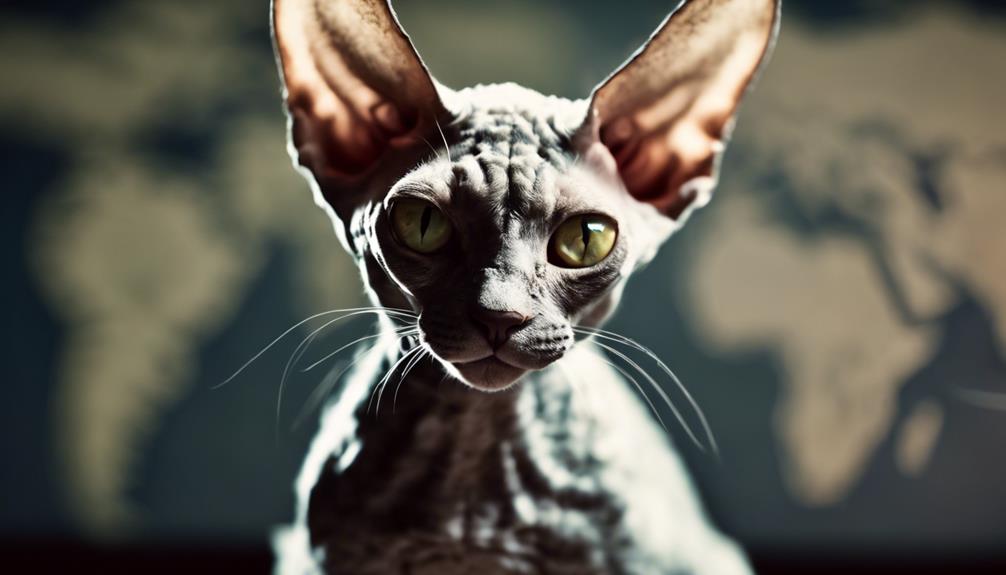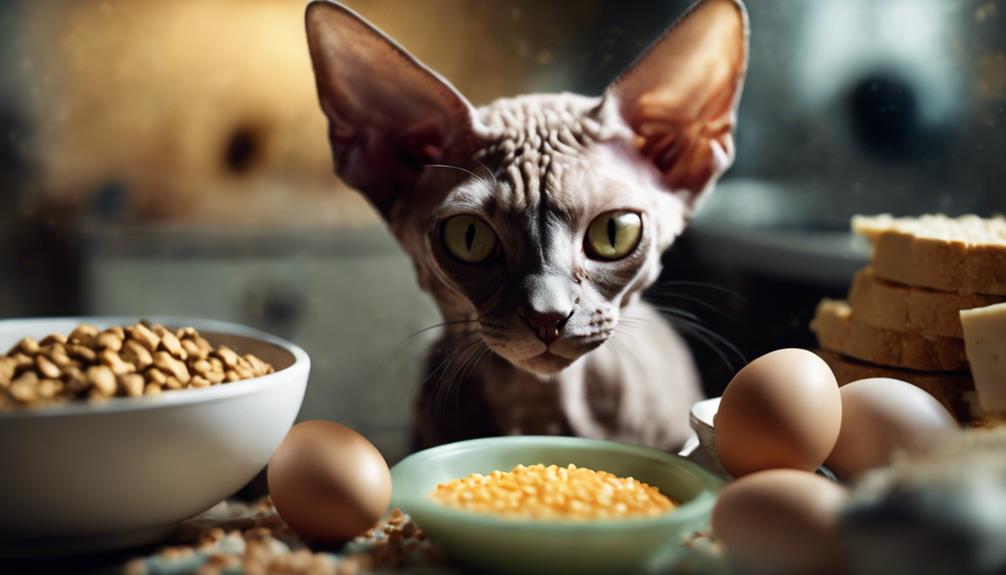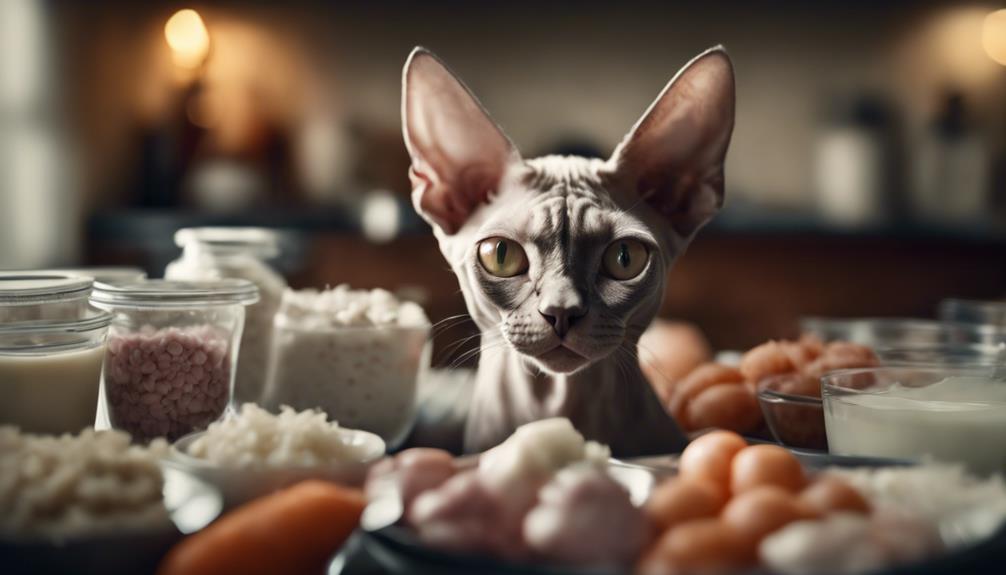As I explore the intriguing world of Devon Rex feline origins, the tale of Kirlee’s discovery near an old tin mine in Devonshire, England, sets the stage for a captivating journey into the breed’s history.
From the initial confusion with the Cornish Rex breed to the revelation of their distinct genetic makeup, the enigmatic roots of the Devon Rex cats offer a glimpse into a fascinating lineage waiting to be uncovered.
Through a lens of curiosity and discovery, let’s unravel the mysteries and uncover the 10 best facts that shed light on the origins of these unique felines.
Key Takeaways
- Devon Rex originated near a tin mine in Devonshire, England in 1960 from a curly-coated kitten named Kirlee.
- Genetic studies confirmed Devon Rex’s unique lineage separate from the Cornish Rex.
- Introduction to the US in 1968 boosted its popularity due to its playful and mischievous nature.
- The breed’s distinct genetic mutation results in its sought-after curly coat and charming personality.
Ancient Origins of Devon Rex
Indubitably, the ancient origins of the Devon Rex breed trace back to a serendipitous discovery near an old tin mine in Devonshire, England in the year 1960. It all began with a curly-coated kitten named Kirlee, born from a genetic mutation. This mutation gave rise to the distinctive appearance that defines the Devon Rex breed today.
Despite initial breeding attempts with Cornish Rex cats, which share some similarities, no curly-coated kittens were produced, solidifying the separation of the two breeds. The Devon Rex quickly gained recognition for its unique charm, playful demeanor, and mischievous personality. Its introduction to the United States in 1968 marked the beginning of its popularity, captivating many with its pixie-like features and lively nature.
Historical Evolution of Devon Rex
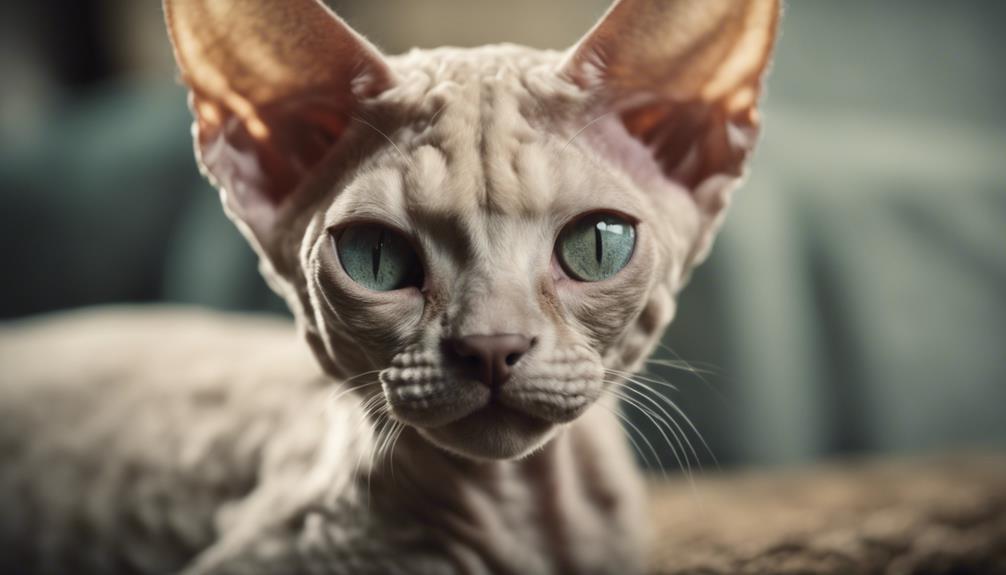
The historical evolution of the Devon Rex breed unfolds through a series of developments that showcase its journey from a serendipitous discovery to a beloved feline companion worldwide. The breed’s evolution is marked by significant milestones:
- Discovery of Kirlee: The origin of the Devon Rex breed can be traced back to 1960 when the curly-coated kitten named Kirlee was found near an old tin mine.
- Confusion with Cornish Rex: Initially, there was confusion linking the Devon Rex to the Cornish Rex due to similar coat traits, but failed breeding attempts highlighted the distinct genetics and coat differences.
- Distinct Breed Confirmation: Through genetic studies and coat analysis, the Devon Rex was confirmed as a separate breed from the Cornish Rex.
- Introduction to the United States: In 1968, the Devon Rex was introduced to the United States, marking a significant step in its global presence.
Origins in Feline History

Emerging from the annals of feline history, the origins of the Devon Rex breed in 1960 mark a significant juncture in the evolutionary tapestry of domestic cats. The breed’s inception can be traced back to a serendipitous discovery of a curly-coated kitten named Kirlee near an old tin mine. This chance encounter near Devonshire, England, laid the foundation for the distinctive characteristics that define the Devon Rex breed today.
Despite initial confusion with the Cornish Rex breed, subsequent breeding attempts between the two confirmed their genetic differences and unique identities. The introduction of Devon Rex cats to the United States in 1968 brought forth their renowned traits of curiosity, playfulness, and occasional mischief, solidifying their place in the hearts of cat enthusiasts worldwide.
Devon Rex Ancestral Lineage

The genetic roots of the Devon Rex trace back to a kitten named Kirlee, discovered near a tin mine in 1960.
Uncovering the ancestral traits of this breed has provided insights into its evolution and distinct genetic makeup.
Exploring the lineage of the Devon Rex sheds light on the unique characteristics that define this curly-coated feline.
Devon Rex Genetic Roots
Originating from a curly-coated kitten discovered near a tin mine in Devonshire, England in 1960, the genetic roots of the Devon Rex breed are distinct and captivating. The unique coat of the Devon Rex is a result of a specific genetic mutation that sets them apart from other feline breeds. Breeding attempts with Cornish Rex cats failed to produce the desired curly-coated kittens, highlighting the genetic separation between these two breeds. The genetic lineage of Devon Rex cats plays a crucial role in shaping their distinctive features and characteristics, making them highly sought after among cat enthusiasts.
- Devon Rex genetic roots trace back to a curly-coated kitten named Kirlee found near a tin mine in Devonshire, England in 1960.
- The unique genetic mutation that gives Devon Rex cats their curly coat is distinct from the mutation found in Cornish Rex cats.
- Breeding attempts with Cornish Rex cats failed to produce curly-coated kittens, confirming the genetic separation between the two breeds.
- Devon Rex cats have a genetic lineage that sets them apart from other feline breeds, contributing to their unique appearance and characteristics.
Ancestral Traits Uncovered
Unveiling the ancestral traits of the Devon Rex reveals a captivating journey into the genetic origins of this unique feline breed. The Devon Rex’s curly-coated genetics are a defining feature that sets them apart from other breeds, such as the Cornish Rex. The breed’s lineage traces back to 1960 when a kitten named Kirlee was discovered near a tin mine in Devonshire, England. This chance finding led to the development of the Devon Rex breed, known for its playful and mischievous nature. Despite failed attempts to produce curly-coated kittens through breeding with Cornish Rex cats, the Devon Rex’s distinct genetic makeup remained intact. The first Devon Rex introduced to the United States in 1968 quickly gained popularity for its charming characteristics.
| Trait | Description |
|---|---|
| Curly-coated genetics | Unique feature setting them apart from other breeds like Cornish Rex |
| Ancestral Origin | Kirlee, found near a tin mine in Devonshire, England in 1960 |
| Development | Breed officially introduced to the United States in 1968 |
| Popularity | Known for its playful and mischievous nature, quickly gaining popularity |
Lineage Evolution Insights
Delving into the evolutionary journey of the Devon Rex lineage provides profound insights into the distinct genetic development of this captivating feline breed.
The lineage of the Devon Rex showcases a unique path of evolution, separate from the Cornish Rex breed, with no genetic relation in coat characteristics. Specific points to consider are:
- The Devon Rex breed emerged in 1960 from a kitten named Kirlee in Devonshire, England.
- Initial breeding trials with the Cornish Rex breed failed to produce curly-coated kittens.
- Confirmation of the Devon Rex as a distinct breed stemmed from its unique coat genetics.
- The introduction of Devon Rex cats to the United States in 1968 sparked their popularity due to their distinctive appearance and playful demeanor.
Tracing Devon Rex Heritage
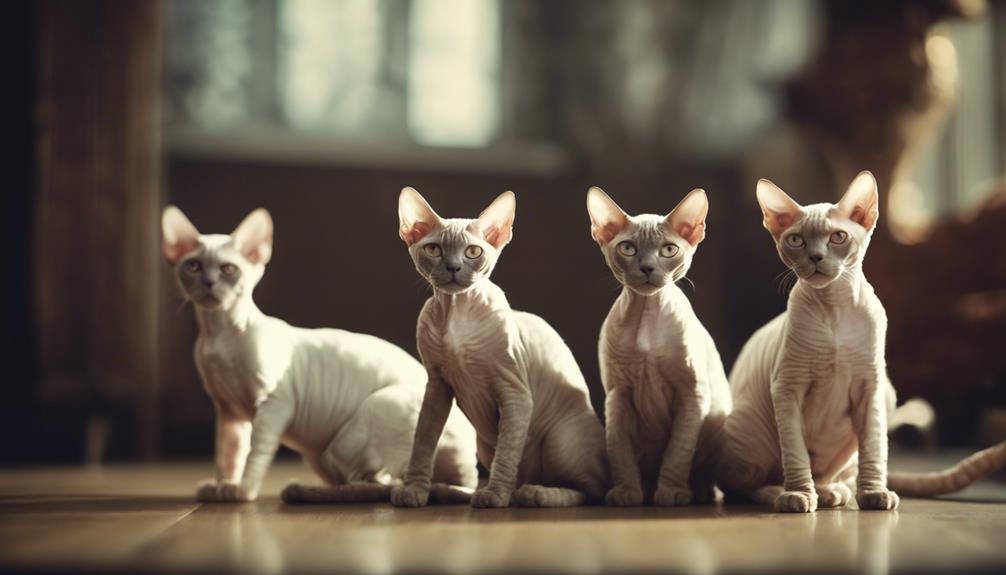
I’ll tell you about the genetic ancestry and evolutionary lineage origins of Devon Rex cats. Understanding where these unique felines come from sheds light on their distinctive traits and characteristics.
Breed’s Genetic Ancestry
Tracing the heritage of the Devon Rex breed reveals a distinct genetic ancestry separate from the Cornish Rex. The genetic lineage of the Devon Rex showcases its unique origins and breeding history. To highlight this point:
- Separate Genetic Lineages: The Devon Rex and Cornish Rex breeds have diverged genetically, evidenced by failed attempts to produce curly-coated kittens through hybrid breeding.
- Distinct Ancestry: The genetic makeup of the Devon Rex differs significantly from that of the Cornish Rex, with no shared coat genetics between the two breeds.
- Failed Breeding Efforts: Efforts to create hybrids between Devon and Cornish Rex cats didn’t succeed, further solidifying the separate genetic heritage of the Devon Rex.
- Establishment of Unique Lineage: The introduction of the Devon Rex to the United States in 1968 cemented its status as a distinct breed with its own genetic lineage.
Evolutionary Lineage Origins
Having explored the genetic ancestry of the Devon Rex breed and its distinct lineage from the Cornish Rex, the evolutionary origins of the Devon Rex can be traced back to its unique beginnings in 1960. The Devon Rex breed emerged from a curly-coated kitten named Kirlee discovered near an old tin mine. Despite initial confusion linking them to the Cornish Rex, separate coat genetics confirmed them as distinct breeds. Breeding attempts between Devon and Cornish Rexes failed to produce curly-coated kittens, solidifying their separate identities. The Devon Rex is celebrated for its playful and mischievous behavior, distinctive appearance, and active nature. This breed’s introduction to the United States in 1968 marked the beginning of its widespread recognition for its unique traits.
| Evolutionary Origins of the Devon Rex | ||
|---|---|---|
| Year | Event | Significance |
| 1960 | Discovery of Kirlee | Birth of the Devon Rex breed |
| 1968 | Introduction to the US | Spread of breed’s recognition |
Genetic Roots of Devon Rex

Originating from a curly-coated kitten discovered near an old tin mine, the Devon Rex breed’s genetic roots can be traced back to a specific mutation that led to its distinctive curly coat. This genetic mutation set the Devon Rex apart from other breeds, highlighting its unique characteristics.
Some key points to consider are:
- The Devon Rex breed’s origin involved a specific genetic mutation leading to its curly coat.
- Breeding attempts with Cornish Rex cats confirmed the distinct genetic roots of the Devon Rex.
- The Devon Rex possesses a different genetic mutation compared to the Cornish Rex.
- Official recognition and separation from the Cornish Rex breed were based on the Devon Rex’s distinct genetic roots and coat characteristics.
Devon Rex: A Historical Perspective

The historical perspective of the Devon Rex breed offers insight into its origins and evolutionary traits.
Originating in Devonshire, England in 1960, the first Devon Rex, Kirlee, was found near an old mine, sparking initial confusion about its relation to the Cornish Rex breed.
Despite failed breeding attempts with the Cornish Rex, later findings confirmed the Devon Rex as a distinct breed with no genetic coat relation.
Origins of Devon Rex
In 1960, near an old mine in Devonshire, England, a curly-coated kitten named Kirlee marked the beginning of the Devon Rex breed. Beryl Cox discovered Kirlee, laying the foundation for this unique feline lineage. Here are some key points about the origins of the Devon Rex:
- Beryl Cox played a pivotal role in finding the first Devon Rex, Kirlee.
- Breeding trials with Cornish Rex confirmed the distinctiveness in coat genetics between the two breeds.
- The introduction of the Devon Rex to the United States in 1968 sparked interest due to its distinctive appearance.
- The breed’s playful nature, curiosity, penchant for mischief, and sociable demeanor akin to a dog make it a popular choice for dynamic households.
Evolutionary Traits of Devon
With its distinctive curly coat and playful demeanor, the Devon Rex has captivated cat enthusiasts worldwide.
The breed’s evolutionary traits have solidified its place as a unique and sought-after feline in the world of cats. The origins of the Devon Rex can be traced back to a specific moment in 1960 when Kirlee, a kitten found near an old tin mine in Devonshire, England, paved the way for the establishment of this breed’s distinctive characteristics.
While early breeding attempts with Cornish Rex cats suggested a potential connection, further exploration confirmed the Devon Rex as a distinct breed with no coat genetics link to the Cornish Rex.
This historical significance, coupled with its rare coat and charming personality, has made the Devon Rex a favorite among cat lovers globally.
| Evolutionary Traits of Devon | ||
|---|---|---|
| Distinctive Curly Coat | Playful Demeanor | Historical Significance |
| Rare and Sought-after Breed | No Coat Genetics Link to Cornish Rex | Established in 1960 |
Feline Lineage of Devon Rex
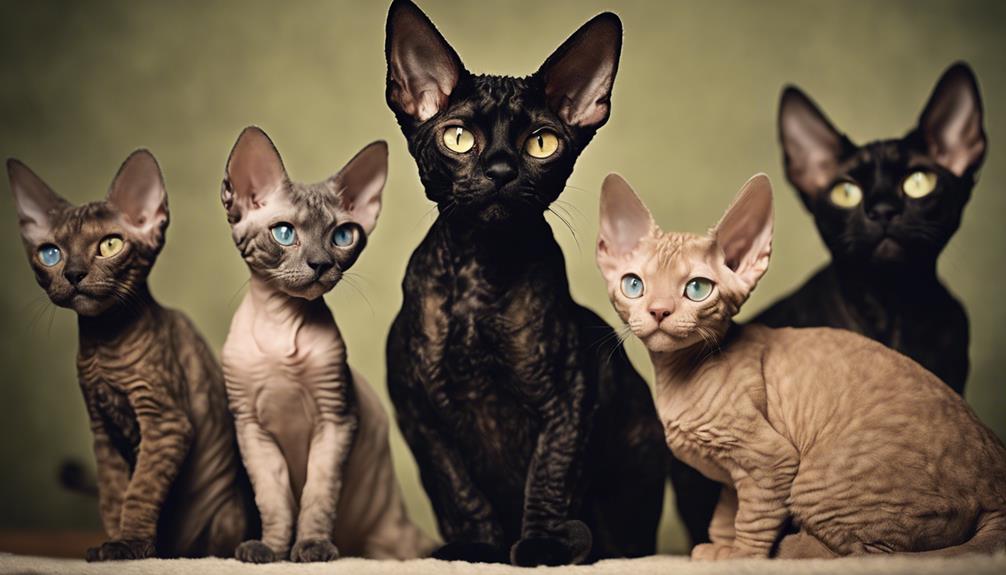
Arising from humble beginnings near a tin mine in Devonshire, England, the feline lineage of the Devon Rex breed traces back to a single curly-coated kitten named Kirlee. This unique breed has a distinct genetic origin, separate from the Cornish Rex, as confirmed through breeding history and genetic studies.
Key points to note about the feline lineage of the Devon Rex include:
- Kirlee, the founding curly-coated kitten, originated near a tin mine in Devonshire.
- Early breeding efforts with Cornish Rex cats failed to produce the desired curly-coated kittens.
- The Devon Rex breed was established in 1960, with Kirlee as its foundation.
- Genetic studies have solidified the Devon Rex and Cornish Rex breeds as separate and unique lineages in the feline world.
Evolutionary Path of Devon Rex
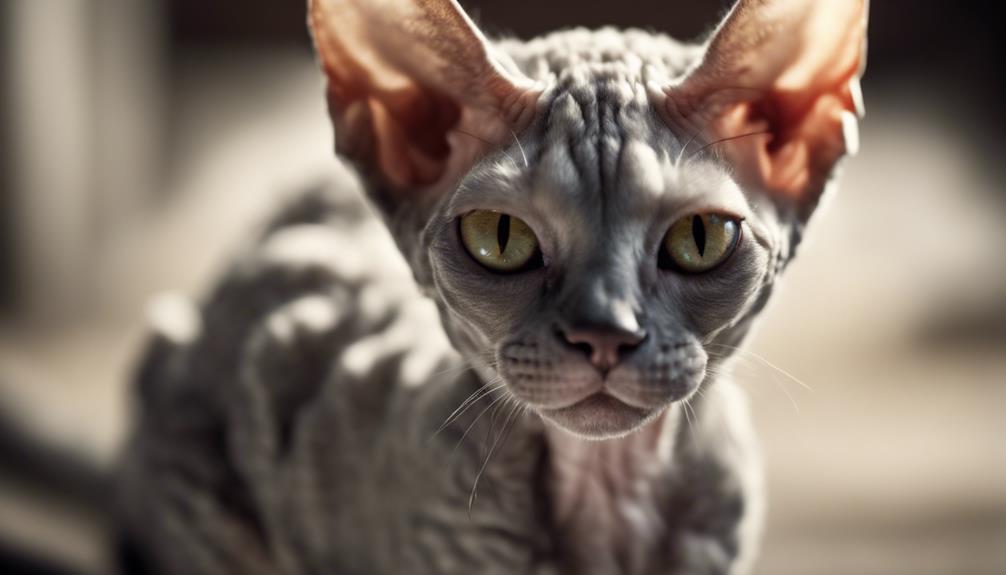
The evolutionary journey of the Devon Rex breed unveils a fascinating tapestry of genetic uniqueness and distinctive traits that set this feline lineage apart in the world of cats.
Originating in 1960 from a curly-coated kitten named Kirlee, the Devon Rex’s genetic makeup showcases its distinctiveness. Breeding endeavors with the Cornish Rex confirmed the breeds as separate entities, each with its own set of characteristics.
Initially discovered near an old tin mine in Devonshire, England, the Devon Rex’s unique coat traits caused confusion, linking it to the Cornish Rex breed. However, further breeding attempts solidified the Devon Rex’s status as a breed of its own.
The official introduction of the Devon Rex to the United States in 1968 marked a significant milestone in its evolutionary path.
Unraveling Devon Rex’s Past
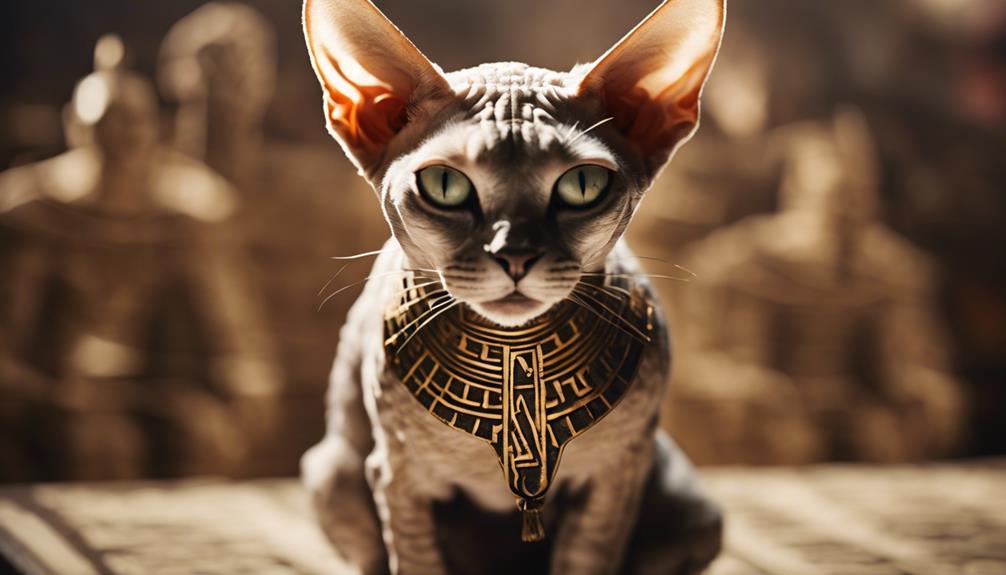
Curiously exploring the historical roots of the Devon Rex breed reveals a captivating journey filled with unique genetic discoveries and distinct breed characteristics. The evolution of the Devon Rex includes fascinating details such as:
- The Devon Rex breed originated in Devonshire, England in 1960 near an old mine.
- The foundation of the Devon Rex breed was a curly-coated kitten named Kirlee.
- Breeding attempts with Cornish Rex cats initially led to confusion about the breeds’ relationship.
- Later confirmation established Devon Rex and Cornish Rex as distinct breeds with no coat genetics connection.
These points highlight the intricate history and genetic uniqueness that define the Devon Rex breed, showcasing its journey from its origins to its distinct place in the feline world.
Frequently Asked Questions
What Is Special About a Devon Rex Cat?
What makes a Devon Rex cat special? Their unique personality and unusual appearance set them apart. With playful energy and an affectionate nature, they are hypoallergenic with minimal shedding. Their curious and intelligent behavior makes them truly captivating.
What Is the Origin of the Devon Rex Cat?
I emerged in 1960 from Devonshire, England, near a tin mine. Genetic mutations birthed my curly coat through Kirlee. Breeding revealed my distinction from Cornish Rex. Introduced to the U.S. in 1968, my playful nature and curiosity captivate many.
How Rare Is a Devon Rex Cat?
Devon Rex cats are relatively rare, not commonly found in standard shelters. Prices range from $600 to $1000. To adopt one, visit a specialized shelter or contact a breeder. Their unique characteristics make them sought after.
What Health Issues Do Devon Rex Cats Have?
As a Devon Rex cat owner, I can attest to the importance of regular vet check-ups for monitoring common health issues like patellar luxation and hypertrophic cardiomyopathy. Proper nutrition and weight management are key preventive measures.

